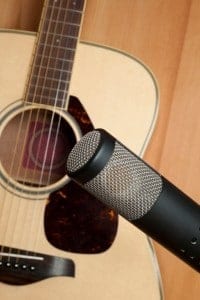Home Recording Academy: How to Record an Acoustic Guitar

The answer to the question “What’s the best way to record an acoustic guitar” is simple: there isn’t a best way. In fact, the acoustic guitar is one of the most difficult instruments to record and achieve your desired sound (whatever that sound may be).
However, the acoustic guitar is also one of the most often recorded instruments in home studios, and we wanted to use this edition of the Home Recording Academy at the Sage Mastering Audio blog to provide some tips on how to record the acoustic at home.
Limitations of Recording Acoustic Guitars in a Home Studio
Two of the biggest considerations that go into how to record are:
- Which microphone to use to record the acoustic guitar?
- What acoustic space is best for the recording?
In large studios, producers and engineers (and sometimes artists) can argue for long periods of time about the best answer to these questions, but in a home studio resources for both can be extremely limited. Often you have to make do with the microphones and space that you have – and this isn’t always a bad thing, as you can become resourceful in your recording techniques, particularly when you have a good idea of the type of sound you want.
The Best Microphone for Recording Acoustic Guitars
Many guides for recording acoustics will tell you that a unidirectional condenser mic is the only way to go, and in a sense they are right. Since condenser mics have better frequency response than dynamic mics , they usually offer a better replication of the natural sound of an acoustic guitar. Additionally, some dynamic mics tend to boost the bass frequencies, making the guitar sound particularly boomy.
That said, if you only have dynamic mics, then by all means you should try different placement options until you get a sound that works for your music. In fact, I’ve personally achieved some great sounds by taking a Shure SM57 dynamic mic off its normal guitar amp-mic’ing duty and using it to record my acoustic. Of course, it all depends on what kind of sound you are trying to achieve.
Microphone Placement for Acoustic Guitars
Typically, the advice if you are only using one mic is to put it slightly above the level of the sound hole (between six and 12 inches from the guitar), pointed slightly down directly at the spot that the neck of the guitar meets the body. However, you can use two mics to record in stereo, usually pointing one toward the sound hole in from further up the neck and one in from the bridge.
But don’t take these as written-in-stone-rules, particularly if you are working with limited resources. Try all kinds of placements until you get the sound you want. Many times studios will “close-mic” the guitar (the 6”-12” distance) with one mic and use another a few feet away to “mic the room” (for the latter, you will definitely want to use a condenser mic).
The Final Word
As mentioned above, the only point is that there is no final word. Should you plug in your acoustic/electric rather than mic’ing it? It’s not usually recommended, but give it a try, it might be exactly what your song needs (though you may want to try plugging it in and mic’ing it). Whatever works for you is the best way to record an acoustic guitar.
A note, however: try to get a good sound from the actual recorded signal, because though you can “fix” certain unwanted sounds with EQ , Compression and other effects, the best way to get the sound you want is to record it that way in the first place.




